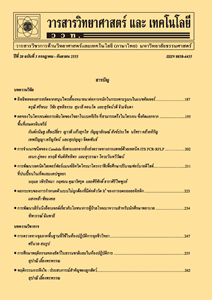การเปรียบเทียบความน่าจะเป็นของความผิดพลาดแบบที่ 1 และกำลังการทดสอบของตัวสถิติทดสอบในการเปรียบเทียบพหุคูณระหว่างการทดสอบอิงพารามิเตอร์และไม่อิงพารามิเตอร์ของแผนแบบบล็อกสมบูรณ์เชิงสุ่ม
Main Article Content
Abstract
Abstract
The objective of this research was to multi-compare the efficiency of control of probability of type I error and power of a test between parametric and nonparametric tests of a randomized complete block design. The 3 parametric test statistics were Student-Newman-Keul’s, Fisher’s Least Significant Difference and Duncan’s New Multiple Range, while the 3 non-parametric tests were Nemenyi, Conover and Friedman. In all cases, we used randomized data with a normal distribution for calculating the probability of type I error, and we used randomized data with a gamma distribution, a chi-squared distribution and an exponential distribution for calculating the power of a test. The sample sizes were 3, 5 and 7 treatments and the number of blocks were 3, 4, 5, 6 and 7 blocks. Three significance levels were used: 0.01, 0.05 and 0.10. The results for probability of type I error revealed that, for controlling probability of type I error, when averages were different but variances were the same and when averages were different and variances were also different, in the case of parametric tests, The Duncan’s New Multiple Range was the best in controlling it, and in the case of Non-Parametric test, The Conover test was the best. For the power of a test, in the case that the gamma distribution had the same averages but different variances and in the cases that the gamma distribution, chi-squared distribution and exponential distribution had both different averages and different variances, in the case of Parametric test, the Fisher’s Least Significant Difference showed the highest power of a test, and in the case of non-parametric test, The Conover test showed the highest power of a test.
Keywords: multiple comparisons; probability of type I error; power of a test
Article Details
References
[2] นิภาพร ขำสะอาด, 2552, อำนาจการทดสอบของการใช้สถิติการทดสอบความแตกต่างของค่าเฉลี่ย, วิทยานิพนธ์ปริญญาโท, บัณฑิตวิทยาลัย มหาวิทยาลัยศรีนครินทรวิโรฒ, กรุงเทพฯ.
[3] บุญชม ศรีสะอาด, 2538, วิธีการทางสถิติสำหรับการวิจัย, ภาควิชาพื้นฐานของการศึกษา คณะศึกษาศาสตร์ มหาวิทยาลัยศรีนครินทรวิโรฒ มหาสารคาม, มหาสารคาม.
[4] ปุณยนุช พินชู, 2548, การเปรียบเทียบค่าความคลาดเคลื่อนประเภทที่ 1 และอำนาจการทดสอบของวิธีการเปรียบเทียบค่าเฉลี่ยรายคู่สำหรับแผนการทดลองแบบสุ่มสมบูรณ์, วิทยานิพนธ์ปริญญาโท, คณะครุศาสตร์ จุฬาลงกรณ์มหาวิทยาลัย, กรุงเทพฯ.
[5] ศรัญญาวรรลยางกูร, 2531, การเปรียบเทียบกำลังการทดสอบแบบพาราเมตริกและนอนพาราเมตริกในการเปรียบเทียบเชิงพหุของแผนการทดลองแบบสุ่มในบล็อกสมบูรณ์, วิทยานิพนธ์ปริญญาโท, จุฬาลงกรณ์มหาวิทยาลัย, กรุงเทพฯ.
[6] Boardman, T.J. and Moffitt, D.R., 1971, Graphical Monte Carlo type I error rate for multiple comparison procedures, Biometrics 27: 738-744.
[7] Cochran, W.G, 1954, Some methods for strengthening the common chi-squared tests, Biometrics 10: 417-451.
[8] Bradley, J.V., 1978, Robustness, J. Math. Stat. Psychol. 31: 144-152.


